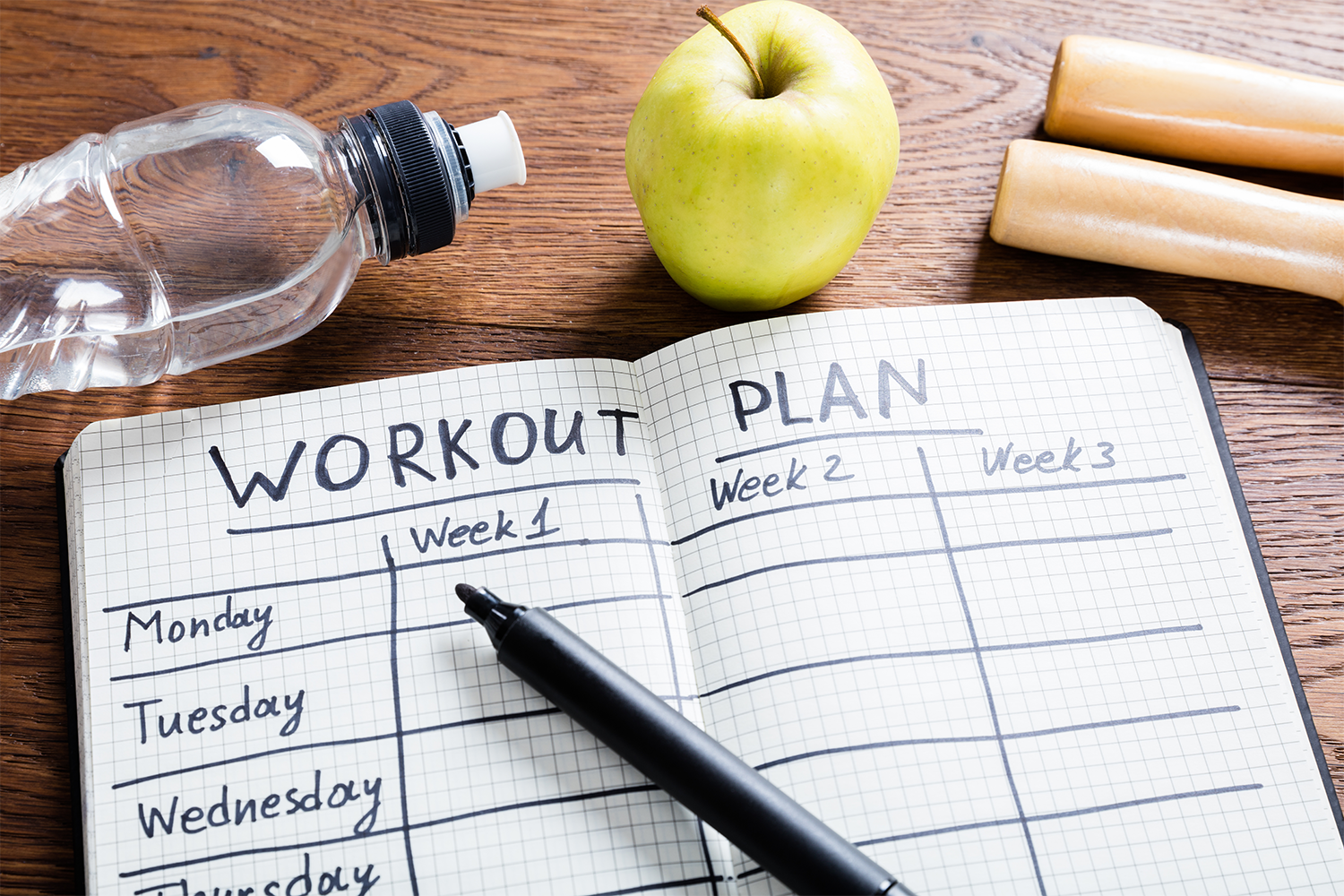When it comes to working out, there is no shortlist of possibilities to choose from.
Biking, running, rowing, HIIT… the list goes on and on! What’s important to note is that what works for one person may not work for another. Just because your friend hits the gym seven times a week doesn’t mean you need to do the same. In the same way, just because you run three miles a day doesn’t mean this will work for another person.
Read on to discover how to make the perfect workout plan for you. You will quickly discover that sticking to your plan is way more achievable when it fits your daily schedule, goals, and interests. Let’s get started!
Types of Workouts
Working out can be accomplished through various exercises, including anything from low-intensity yoga moves to high-intensity interval training or cardio. When considering the different options for working out, consider your goals and interests.
Do you love being outside? If so, running or biking might be your solution.
Do you love lifting weights? If so, going to the gym and using the dumbbells and exercise machines might be your solution.
Do you enjoy working out at home? If so, a rowing machine or a ski-trainer might be your solution.
Choose something that interests you and will keep you working out long-term! Consider some of the exercises below to start piquing your interest in different options.
Cardiovascular Exercise
This type of exercise has multiple benefits on all parts of your body but primarily targets your endurance capacity as well as your heart and lungs. You should engage in moderate cardiovascular training 30 minutes a day for five days a week or in vigorous physical activity for 20 minutes a day, three days a week.
If engaging in moderate exercise, you should carry on a conversation during the workout while still raising your heart rate. On the other hand, when doing vigorous cardio, you will likely be unable to hold a conversation at the same time.
Some options for cardio workouts vary and include the following:
- Running: This can be done outside in a neighborhood, on a trail, or on a treadmill
- Biking: Just as with running, this can be done outside or on a stationary bike
- Swimming: You have a pool available in your neighborhood or at your gym; this is a great option for taking laps.
- Skiing: If you enjoy being in the snow and the mountains, this is a great workout. Or, if you enjoy skiing but don’t have the location to do so, consider purchasing a workout machine with a skiing option.
- Tennis: This could be a fun and interactive activity for you and your friends. Go to your local park or tennis courts and give this sport a try!
- Zumba: Dancing is a great way to be active while also having a great time. Who doesn’t love a good dance party? Zumba classes can be found online as well as offered at gyms and other fitness studios.
- Rowing: Do you have an interest in rowing? If so, these rowing machines are an excellent option for your garage gym workout!
- Ski-Training: EnergyFit’s Ski-Row trainer offers a dual-function high intensity interval training all in one machine. While you can perform rowing or skiing-only workouts, you can also perform mixed-erg workouts for optimal results.
Strength Training
Strength training increases your heart rate, although not as much as a cardio workout does. Instead, strength training targets your muscles and bones. You should engage in strength training at least twice a week and should aim to strengthen all major muscle groups within that time.
This can be done by engaging in full-body training to target everything in one workout, or you may focus on specific muscle groups at different times.
Some major muscle groups include:
- Lower body: quads, hamstrings, calves
- Upper body: biceps, triceps, shoulders
- Hips
- Back
- Chest
- Abdomen
- Glutes
It is recommended to engage in eight to 12 repetitions per exercise and two to three sets of the exercise for each workout. Remember the importance of letting your body rest between strength training. After all, your muscles benefit from 48 hours of recovery between each training session.
High Intensity Interval Training
High-intensity interval training (HIIT) incorporates a mixture of strength training and cardiovascular work all in one routine. High-intensity interval training is often shortened to HIIT and incorporates periods of high-intensity activity followed by a lower-intensity activity for set amounts of time.
For instance, you may do 50 seconds of burpees for the high-intensity segment followed by 10 seconds or a plank or no exercise for the low-intensity segment. This type of exercise was seen to have the most significant benefit in weight loss and cardiovascular health, as it targets the full body and achieves a high calorie burn all in one routine.
Core Training
Having a strong core is a vital part of our posture, balance, stabilization, and protection of the spine during movement. Core training is known as the conditioning of the muscles around the middle of the body. These include the abdomen, hips, pelvis, and lower back.
Several moves are efficient for strengthening your core muscles, such as:
- Sit-up crunch
- The cobra
- Back extensions
- Standing woodchoppers
- Planks
- Side planks
- Abs
Tips for Creating Your Perfect Workout Plan
While the list above gives a wide variety of exercises to choose from, the length of it might be overwhelming. Therefore, choosing your goals, understanding your fitness level, and knowing your options are vital in deciding on your workout plan.
Incorporating Both Cardio and Strength Training
This is the first step in determining your workout plan. Do you want to focus more on cardio? Strength? Maybe both? When working out, the most benefits will come from a combination of cardio and strength and making sure to target different muscles each day.
If you’re among many beginners, these two simple steps may be helpful to get started with a workout program:
-
Choose two cardio exercises you enjoy: Look at the list above and choose two things you want to engage in. Remember to pick this realistically depending upon your area, the workout equipment you plan to invest in, and your overall workout space.
Whatever it may be, having two options on hand will allow you to work out without getting bored from the one exercise alone.
For example, choose an outside jog as your cardio workout and a rowing machine routine for your second cardio workout. Then, you can do one or two of these workouts each week instead of doing three to four of the same thing. You can also add additional cardio workouts if you prefer to have three or more to choose from.
-
Choose your weight training preference: After choosing your cardio, remember to pick what you enjoy in terms of weight training. If you work out at home and like to do bodyweight exercises, this is a great option for your routine. Or, if you visit the gym and prefer to use dumbbells or weight machines, this is also a good option.
The important thing is not the exact location or equipment you use, but rather picking something that will stick long-term. In addition, if you get bored with your current workout schedule, switch it up! Nothing is stopping you from finding something new to engage in.
Finding a Routine
When it comes to working out, it’s important to find a routine that works for you.
Some people enjoy exercising at the gym while others prefer staying home. This is entirely up to you. Being at the gym gives you a wide variety of workout machines, weights, and other amenities to choose from while being at home allows you to be in your comfort zone without leaving your environment.
Both are great options for working out. If choosing to stay at home, ensure you have the space and equipment you need to work out. We will discuss some of the necessary equipment below.
- Do I want to have a workout buddy, or do I prefer exercising alone? Do I want a personal trainer?
When working out, determine if having a workout buddy or personal trainer will benefit you. Some people find it helpful to have a friend for accountability, while others find a personal trainer helpful for figuring out the best workouts and routines to engage in. On the other side of things, some people prefer creating their own routine, goals, and schedule and don’t want to work out with others.
- What time of the day do I want to work out?
When planning your workout, choose a time that fits comfortably into your schedule. For example, if you hate getting up early, don’t plan your workout for 6 am. Chances are, you will snooze your alarm 15 times and won’t end up working out.
This could leave you feeling discouraged and frustrated. Instead, decide when you have the most energy. Maybe this is after work in the evenings, during your lunch break, or maybe before you leave for work. Picking a time that you feel most energized will help you stick with your routine.
Pick Exercises That Are Safe for You
Another suggestion for picking your perfect workout plan is to figure out what you can handle physically. For instance, if you have a heart condition, don't invest in a treadmill and run a marathon. Instead, see your healthcare provider and determine what exercises are safe and beneficial to you.
Don’t fall into the trap of comparing your workouts to others because two people may not do the same routine. In addition, if you have issues with your muscles, bones, or joints, consult your doctor before doing intense and heavy lifting.
If first beginning your workout routine, start with lower weights and fewer time intervals and slower and more evenly paced cardio. This will allow you to slowly increase your time and weight as you work out and prevent you from becoming burnt out and exhausted. Starting too fast and too hard could also result in injury and keep you from working out long term.
Best Workout Locations: Pros and Cons
There are many locations to choose from when beginning your workout routine, all of which come with several pros and cons:
The Gym
This is the first location you might consider when beginning an exercise routine. There are many benefits to a gym as well as some disadvantages.
Pros:
- Plenty of gym equipment to choose from, ranging from cardio machines to weight machines.
- Gym classes and personal trainers are available.
- Other amenities are sometimes available, including pools, hot tubs, saunas, hydromassages, etc.
Cons:
- Fee for a monthly gym membership.
- Not always a clean environment due to multiple people using the same machines.
- Closed on holidays and sometimes overnight depending on the gym.
- The temptation to compare your workout progress with those around you.
At Home
Working out at home is another great location. For some, a workout at home may be frequently skipped or forgotten about, while for others, this may increase participation in the routine. Just as with the gym, there are many pros and cons to this workout location.
Pros:
- No monthly gym costs.
- Cleaner environment.
- Available anytime, day or night.
- Ability to focus on your progress without comparing it to anyone else.
- Workout location is readily available and accessible.
Cons:
- Not as much equipment is available.
- It can be expensive to invest in equipment first, starting out.
- Lack of additional amenities.
- No classes or personal trainers as easily accessible.
- You may have limited space.
Outside
Working out in the outdoors is also a good option for your routine. Whether this is a park, your backyard, or even the surrounding area for a run, being outdoors is shown to affect your mood and energy levels positively. As you might guess, this too comes with several pros and cons.
Pros:
- Being in the fresh air increases your energy and mood.
- No cost to exercising outside.
- Larger space to workout in.
Cons:
- Unpredictable weather may interfere with your workout.
- Higher risk of dehydration if it’s a hot day.
- It may not have a safe location to do strength training in.
What Workout Equipment Do I Need?
The workout equipment you need depends upon the exercises you choose from and the location you do them in. However, this list may help determine some of the most commonly used exercise equipment and accessories to make the most out of your workout.
Dumbbells, Kettlebells, Medicine Balls, Resistance Bands
These are great options when participating in strength training. Pick the weight based on your physical strength and ability and increase it as you become more proficient in your routine. Resistance bands are also a safe option for those that want added resistance but don’t want to hold a weight or ball.
Cardio Machines
A cardio machine can be any number of things, including:
- Treadmill
- Stair stepper
- Stationary bike
- Elliptical
- Rowing machine
- Ski-trainer
Other Accessories
Several other items can be helpful in your workouts, including:
- Yoga mat
- Water bottle
- Headband
- Headphones for music
- Smartwatch
- TV for videos to guide your exercise
EnergyFit’s Workout Solution
Did you know that EnergyFit’s rowing machines come with the ability to do rowing, skiing, and HIIT workouts? The Ski-Row Air and the Ski-Row Air+PWR may be exactly what you need for your workouts. Whether you choose to always work out at home or you want equipment for days with limited gym time, this is a great option.
There are many advantages to these machines, as seen below. In addition, there are a variety of workouts to choose from, with videos that explain each exercise.
- The ability to choose between rowing, ski training, or mixed erg HIIT workouts
- Convenient front-mounted wheels for easy transport
- Ability to be folded up and stored away when not in use
- Bluetooth
- Heart rate connectivity
- Adjustable foot straps
- Console readouts with time, pace, stroke, rate, distance, calories, watts, and heart rate
- Programs involving time, distance, or calorie goals, and time or distance intervals
Wrapping It Up
Considering key points to take away from this article, remember that your workout options are endless and that no one routine will work for all individuals. Instead, consider some of the things we discussed in choosing your workout, such as what exercises excite you, the location you prefer, your fitness level, etc. If you want a workout machine to keep at home, consider EnergyFit’s rowing machines to meet all your fitness needs.
If you want to work towards muscle gain or just staying in shape, both are possible with workout plans that involve compound movements, full-body workouts, weight lifting, or cardio.
Now that you have an idea of choosing your perfect workout, what are you waiting for? It’s time to get moving!
Resources:
7 tips for a safe and successful strength training program | Harvard Health
Harnessing the power of high-intensity interval training | Harvard Health
Core Training, Definition, Purpose, Description, Precautions | JRank





Leave a comment
All comments are moderated before being published.
This site is protected by hCaptcha and the hCaptcha Privacy Policy and Terms of Service apply.